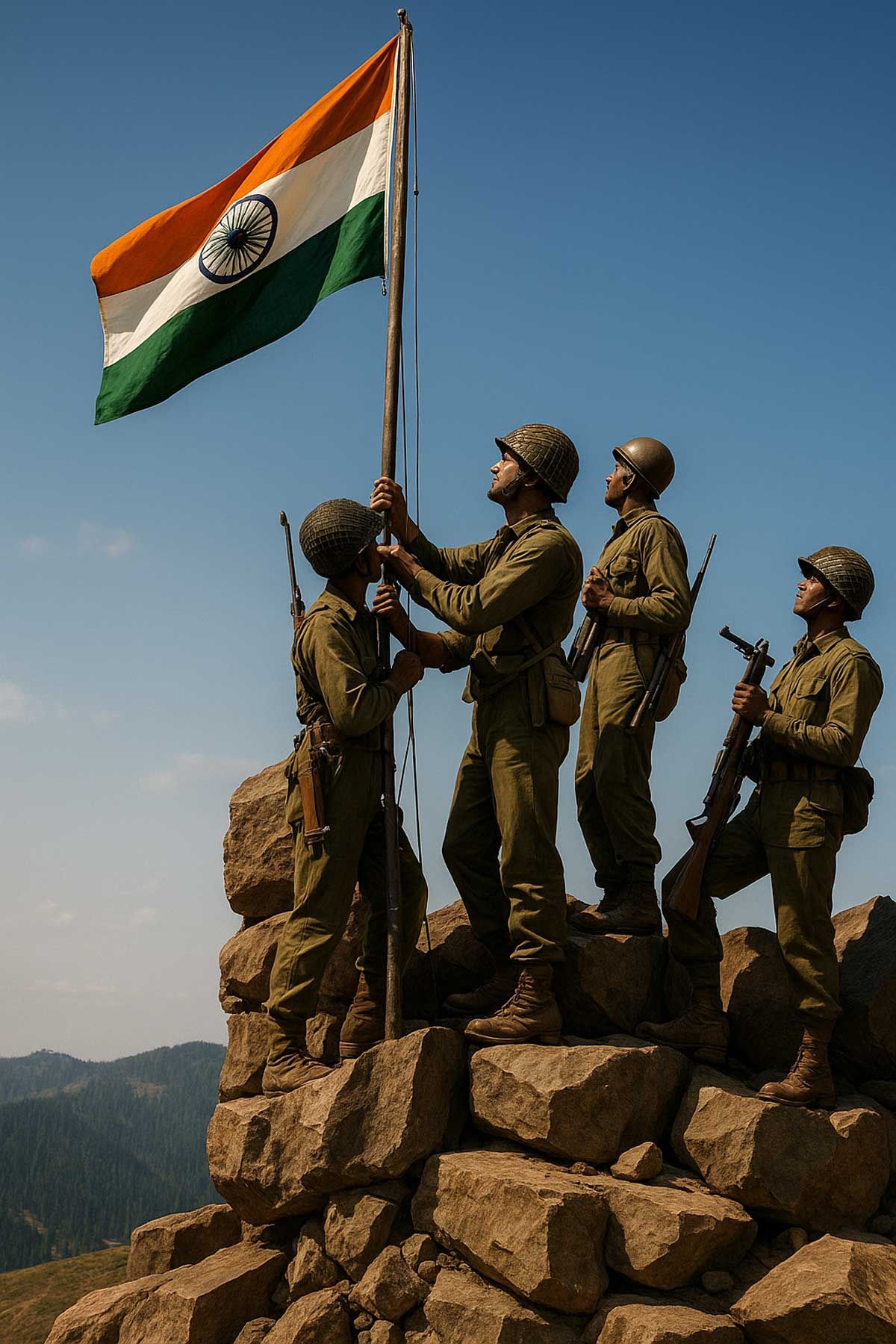More Coverage
Twitter Coverage
Satyaagrah
Written on
Satyaagrah
Written on
Satyaagrah
Written on
Satyaagrah
Written on
Satyaagrah
Written on
JOIN SATYAAGRAH SOCIAL MEDIA
India captured Haji Pir Pass in 1965 after a daring operation, but returned it in 1966 at Tashkent, losing a vital infiltration block; decades later, that strategic blunder by Congress still fuels cross-border terror and haunts India’s national security

As grief slowly turns into burning rage, India once again faces the grim and painful reality of terrorism sponsored from across its western border. Years and decades of Pakistan's deliberate encouragement and covert support of violent jihadist activities have pushed India to a tipping point. New Delhi, responding swiftly, is now moving to diplomatically isolate Islamabad while also cautiously planning tougher and more resolute countermeasures behind the scenes.
|
The trigger for this fresh wave of fury is the horrifying massacre at Pahalgam, which shook the conscience of the entire nation. Hindu tourists were meticulously identified, hunted down, and mercilessly executed in cold blood. Reports revealed the shocking details of the attackers religiously profiling victims, with some even forced to disrobe to confirm circumcision—an appalling and grotesque display of hate. The sheer brutality of this slaughter, the carefully planned targeting, and the indescribable humiliation inflicted upon innocent civilians have set off an eruption of nationwide anger. India is no longer content with just mourning; it is loudly and unmistakably demanding justice—and beyond that, a stern retribution.
Yet, even in this hour of national anguish, political unity remains elusive. The knives of political rivalry are already out, with some Congress leaders choosing to mock and openly challenge the government instead of standing united against terror. Former Punjab Chief Minister Charanjit Singh Channi publicly cast doubt on the Balakot airstrikes carried out by the Indian Air Force. Another Congress leader, Ajay Rai, took political theatrics to a disturbing level by parading around with a toy Rafale jet decorated absurdly with lemons and chilies—actions blatantly trivializing critical national security concerns. This was indeed political theatre at its absolute worst, mocking both the nation's grief and its resolve.
Even more disturbing is the selective memory or deliberate amnesia exhibited by the Congress. In their attempt to portray Prime Minister Modi and the BJP as hesitant or weak in confronting Pakistan—a claim the BJP swiftly and robustly rejects, especially when contrasting Modi’s actions with former Prime Minister Manmohan Singh's inaction following the devastating 26/11 attacks—the Congress conveniently ignores its own troubled and damaging legacy. Over decades of Congress rule, a series of grave geopolitical and strategic errors were made, which directly contributed to the ongoing crisis in Kashmir.
One of these critical and costly errors was the decision to return the Haji Pir Pass.
|
The mountain pass that should have never been returned
India's extraordinary military triumph over Pakistan in the 1965 war offered an unprecedented and historic strategic advantage. Among the most significant territorial gains was the Haji Pir Pass. Positioned dramatically at an altitude of 2,637 meters in the formidable Pir Panjal mountain range, this was far more than just high ground—it was a strategic asset of immense tactical importance. The pass provided India with a vastly shorter, safer, and strategically critical corridor connecting Jammu and Kashmir, which would have significantly impeded cross-border infiltration from Pakistan.
In August 1965, beneath the shadow of heavy monsoon clouds and amidst relentless enemy fire, the Indian Army executed a daring, near-impossible military operation. Major (later Lt Gen) Ranjit Singh Dayal led a small group of elite soldiers from the renowned 1st Para Special Forces through the dangerous, slippery, and virtually inaccessible terrain of the Hyderabad Nallah. With only biscuits packed as their sustenance, these soldiers courageously advanced under the protective cloak of darkness and heavy rainfall. Their grit and determination were extraordinary. By the break of dawn on August 26, against all odds, they had succeeded—the strategically vital Haji Pir Pass was securely in Indian hands.
This operation was nothing short of remarkable—a genuine military miracle accomplished with sheer bravery, strategic brilliance, and minimal resources.
At this time, Pakistan was deeply engaged in executing "Operation Gibraltar"—an aggressive strategy aimed at infiltrating thousands of irregular fighters into Jammu and Kashmir, using the Haji Pir Bulge as a convenient infiltration route. Vast caches of arms and ammunition were being secretly stockpiled behind enemy lines. Recognizing the imminent threat, Indian Army Chief General J.N. Chaudhury decisively called for swift and aggressive action. His directive was straightforward and bold: “Make them react to us,” he ordered—and this is precisely what the Indian Army did, swiftly turning the tables on Pakistan.
Haji Pir Pass was captured by Indian Armed Forces in 1965 war
The daring operation to seize the Haji Pir Pass by the Indian Army was not merely a symbolic victory; it decisively disrupted Pakistan’s meticulously laid plans. By capturing this strategic location, India effectively blocked critical infiltration routes that Pakistan intended to exploit, throwing their aggressive designs into utter chaos. However, India's triumph soon faced a fierce and desperate Pakistani response. Just days after losing Haji Pir, Islamabad launched Operation Grand Slam, a swift and aggressive blitzkrieg-like offensive aimed directly at Akhnoor. The clear intent was chilling—to sever the vital link between Jammu and Kashmir and the rest of India, effectively isolating the region entirely.
Recognizing the imminent threat, India rapidly mounted a powerful counter-offensive. On September 6, Indian forces launched bold attacks penetrating deep into Pakistan, targeting strategically vital areas around Lahore and Sialkot. This audacious maneuver forced Pakistan’s forces into a defensive retreat, narrowly preventing a potential disaster. Had Operation Grand Slam succeeded, Pakistan would have controlled the critical Jammu-Srinagar highway, thereby capturing the entire state. Thankfully, disaster was narrowly averted, but only just.
Yet, the hard-earned strategic advantage, won by the blood, bravery, and sacrifice of Indian soldiers on the unforgiving terrain, was short-lived. Diplomacy, distant from the battlegrounds, would soon reverse this crucial achievement, undermining India's military gains.
|
Tashkent: Where strategic advantage was traded for the chimera of peace
Merely five months after this critical victory, in a distant diplomatic setting thousands of miles away, India's strategic advantage slipped irreversibly through its fingers. During the Soviet-brokered peace talks held at Tashkent, Prime Minister Lal Bahadur Shastri agreed, inexplicably, to return the strategically vital Haji Pir Pass back to Pakistan. The Tashkent Declaration was formally signed on January 10, 1966, sealing India's diplomatic surrender. Tragically, the very next day, Shastri died mysteriously, further deepening the sense of betrayal felt across the nation. For countless Indians, this was not diplomatic negotiation—it was capitulation, plain and simple.
This decision became a disturbing precedent, especially starkly remembered during the 1971 Bangladesh war of liberation, when India again chose diplomacy over strategic interest. Despite capturing approximately 93,000 Prisoners of War from Pakistan, India inexplicably agreed to release them, once more chasing the elusive illusion of lasting peace with a nation that has historically defined its very existence by deep-seated hostility towards India.
The Indian military establishment was shocked and stunned by the decision taken in Tashkent. This diplomatic surrender had two devastating consequences. Firstly, it allowed Pakistan to regain control over a key infiltration corridor, enabling endless insurgencies and terrorist attacks. Secondly, India relinquished a priceless geographic advantage—territory that had the potential to permanently transform the Kashmir conflict in India's favor. And yet, despite the hard-earned advantage, India willingly surrendered the very terrain that could have permanently secured its strategic flank.
|
A missed opportunity in 1971
In the immediate aftermath of the 1965 ceasefire, India undeniably held significant strategic leverage. Pakistani forces had come dangerously close—just four kilometers from the crucial Akhnoor bridge. Driven by fear of a renewed Pakistani offensive that could endanger Jammu, Indian policymakers made a critical decision. In return for Pakistan’s withdrawal from the sensitive Chhamb region, India agreed, reluctantly, to give back control of the Haji Pir Pass—a decision that would haunt strategic thinkers for decades to come.
However, the real tragedy was yet to unfold. Despite a golden opportunity during the decisive 1971 war, when India enjoyed overwhelming military superiority and strategic momentum, it surprisingly never attempted to retake Haji Pir. Lt Gen Ranjit Singh Dayal, the architect of the original 1965 victory, later reflected with deep regret, stating clearly: “It was a mistake to hand it back. Our people don’t read maps.”
Indeed, maps narrated the strategic truth with unerring clarity. Maj Gen (Retd.) Sheru Thapliyal emphasized how keeping Haji Pir would have drastically limited Pakistani infiltration into the Kashmir Valley, Poonch, and Rajouri. It could have dramatically shortened the vital road connecting Jammu to Srinagar via Uri and Poonch by 200 kilometers, making the route significantly safer and easier to defend.
Veteran special forces officer P.C. Katoch offered an even starker analysis: the pass might appear modest in terms of altitude, but its military significance was unquestionably immense. The bitter irony? India’s crucial strategic advantage was lost—not in the fierce heat of battle—but quietly, inexplicably, around a diplomatic negotiating table.
|
Strategic advantage lost at a negotiating table
The painful saga of Haji Pir is more than a historical footnote; it serves as a profound lesson in strategic decision-making, vividly illustrating the stark divide between military victories and political compromises. This narrative is a reflection of India's struggles with strategic clarity—of extraordinary victories achieved by courageous soldiers being squandered by politicians who lacked the foresight or willingness to recognize their importance. It is a story of maps misunderstood, sacrifices forgotten, and strategic lessons repeatedly ignored.
Today, as India faces yet another violent provocation, the memory of the Haji Pir fiasco becomes critically important, serving as an enduring and solemn reminder. Some strategic opportunities rarely, if ever, come a second time. When they do appear again, the nation must not hesitate, falter, or forget the past's painful lessons. Some mistakes might eventually be forgiven or forgotten by history. However, others, like the strategic blunder involving Haji Pir, remain permanently etched into the rugged mountains themselves—forever seared into the consciousness of a nation that must heed its historical mistakes if it hopes to secure a peaceful, secure, and strategically sound future.
 Support Us
Support Us
Satyagraha was born from the heart of our land, with an undying aim to unveil the true essence of Bharat. It seeks to illuminate the hidden tales of our valiant freedom fighters and the rich chronicles that haven't yet sung their complete melody in the mainstream.
While platforms like NDTV and 'The Wire' effortlessly garner funds under the banner of safeguarding democracy, we at Satyagraha walk a different path. Our strength and resonance come from you. In this journey to weave a stronger Bharat, every little contribution amplifies our voice. Let's come together, contribute as you can, and champion the true spirit of our nation.
 |  |  |
| ICICI Bank of Satyaagrah | Razorpay Bank of Satyaagrah | PayPal Bank of Satyaagrah - For International Payments |
If all above doesn't work, then try the LINK below:
Please share the article on other platforms
DISCLAIMER: The author is solely responsible for the views expressed in this article. The author carries the responsibility for citing and/or licensing of images utilized within the text. The website also frequently uses non-commercial images for representational purposes only in line with the article. We are not responsible for the authenticity of such images. If some images have a copyright issue, we request the person/entity to contact us at This email address is being protected from spambots. You need JavaScript enabled to view it. and we will take the necessary actions to resolve the issue.
Related Articles
- British PM accepted that “the tide of nationalism is running very fast in India" and the mutiny of the Royal Indian Navy in 1946 forced colonial masters Britain to leave India: What followed was betrayal by Congress
- "Not a pin was manufactured, really?": Indians counter Congress leader's claims, asserting Nehru's socialist zeal post-Independence crippled Indian industries, debunking myths of his economic ingenuity & exposing enduring consequences on national progress
- If only India’s partition chilling wound was not enough, Gandhi did his last protest again only to blackmail India into giving 55 crores to Pakistan, dragged Hindu, Sikh refugees seeking shelter in mosques to die in cold: And we call him Mahatma, not for
- "You cannot change what you refuse to confront": Ashutosh Lahiry approached Nehru seeking assistance for the suffering Hindu refugees and to take action to alleviate their plight, but Nehru refused citing his commitment to Gandhian pacifism and secularism
- Netaji, an Impossible man can never be boxed into an ideological corner: Not just the most enigmatic figure in world history but his life is also a tough lesson in how to think about history
- Harmonizing Nathuram Godse: Why India should move beyond denouncing him, a man who altered the course of not only the politics of the country but the very history of the Hindu Civilisation and, by extension, the world at large
- Nehru's Himalayan Blunders which costed India dearly - Pre-Independence
- "It cannot be when the root is neglected that what springs from it will be well ordered": Nehru shouted, 'Total rubbish! We don’t need a defence plan. Our policy is ahimsa. We foresee no military threats. Scrap Army! Police are good enough for security’
- During ‘Kheti Bachao Yatra’ in Kurukshetra Shehjada Gandhi claimed of throwing China out from Indian Territory ‘in 15 minutes’: From Nehru’s Himalayan blunder to UPA’s silence as China took over Indian land in Ladakh
- When Secular Nehru Opposed Restoration Of Somnath Temple - The Somnath Temple treachery
- Congress created magic on paper to make 17 crores poor by changing the estimated poverty line in a rural area and urban area: PM Modi tears into Congress’ ‘Garibi hatao’ facade, exposes the reality of 2013 report
- Historian with Communist glasses: When Pandit Nehru rose to unrivalled power and position in India his book 'Glimpses of World History' was recommended as a reliable reference work for advanced students of history in Indian universities
- Ghost from the past: Unseen picture of Nehru voting in favour of partition of India goes viral
- The first large-scale massacre in Independent India accounts for one of the biggest coverups in modern history: It is about time we talk about the 1948 genocide of Maharashtrian Brahmins following MK Gandhi’s assassination
- "In loyalty's absence, betrayal finds its stage": Indians sacrificed their life earnings to Netaji for a dream called freedom, Nehru, however, fancied a different richness: gifting it to Pakistan, Legacy decisions, they call it was one more great betrayal




























